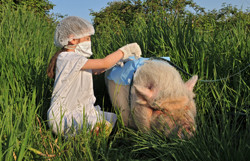Unravelling the drivers of zoonosis
The PREDEMICS(opens in new window) (Preparedness, prediction and prevention of emerging zoonotic viruses with pandemic potential using multidisciplinary approaches) project focused on common zoonotic viruses to discover what determines their emergence and develop appropriate interventions. Researchers used different virus models to elucidate virus replication efficiency, pathogenesis and transmissibility, and identified several associated key factors. They found that the viral isolates from patients with severe H1N1 infection had higher genetic heterogeneity compared to patients with mild disease, underlining the importance of genetic variation in virus adaptation. A major accomplishment was the development of a platform for rapid and simultaneous antibody detection of different infectious pathogens in biological fluids from humans and animals. PREDEMICS also developed powerful computational methods and models to determine the phylodynamics and phylogenomics of viruses such as rabies, human influenza virus and Ebola. Detailed analyses of the avian influenza epidemics revealed the emergence of various mutations that may have increased the fitness of H7 viruses in poultry. Experiments on the influenza A virus indicated that its survival depends on the original host species as well as the properties of the viral haemagglutinin protein. Studies on infected bat colonies and red fox populations provided new insights. For instance, seroprevalence of lyssaviruses depends on bat colony size and number of species. Incubation- and immune-period durations were the most relevant drivers of virus persistence. Study results also highlighted the importance of migration and ecology in disease dynamics. This could aid in developing better infection control methods in wildlife. Project partners also investigated the viral mechanisms involved in evading the host’s innate immunity, focusing on the modulation of different interferon pathways to identify molecular factors central to the infection process. In addition, they developed novel intervention strategies against Japanese encephalitis virus based on recombinant vaccines or attenuated strains. These techniques involved a combination of approaches based on de novo synthesis, random codon re-encoding and infectious-subgenomic-amplicons. PREDEMICS findings can be used to design effective disease prevention, control and treatment strategies as well as for improving pandemic preparedness and response.







